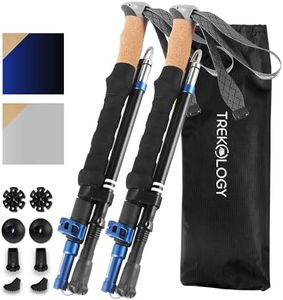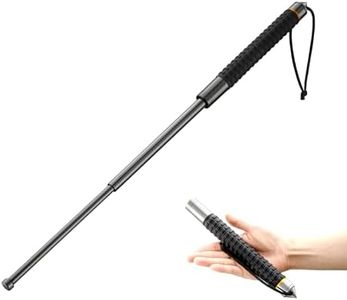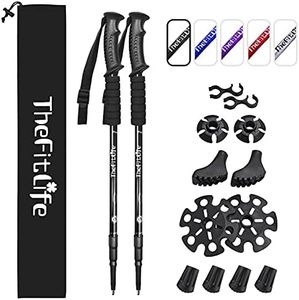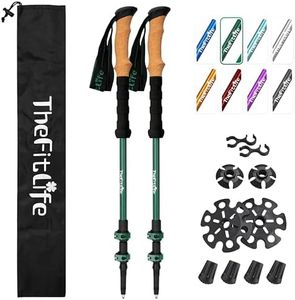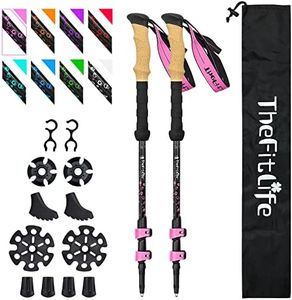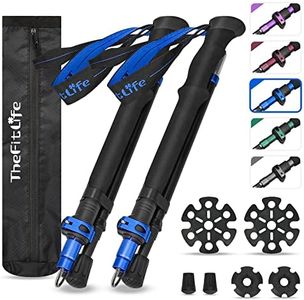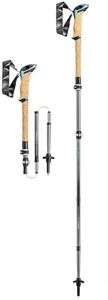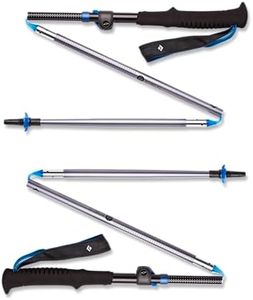We Use CookiesWe use cookies to enhance the security, performance,
functionality and for analytical and promotional activities. By continuing to browse this site you
are agreeing to our privacy policy
10 Best Hiking Sticks
From leading brands and best sellers available on the web.Buying Guide for the Best Hiking Sticks
Choosing the right hiking sticks can make a big difference in your comfort and safety on the trail. Hiking sticks, also known as trekking poles, help you maintain balance, reduce impact on your joints, and provide stability on uneven ground. To pick the best fit, it's important to think about the kind of hiking you do, your body size, and your personal preferences. Understanding the key specs will help you make a smart choice so that your hikes are safer and more enjoyable.MaterialThe material of hiking sticks affects their weight, strength, and durability. Most commonly, hiking sticks are made from aluminum or carbon fiber. Aluminum poles are tough and can handle rough treatment, but they're a bit heavier. Carbon fiber poles are lighter, which makes long hikes easier, but sometimes they can break if bent too much. If you often hike in rocky or rugged terrain, a stronger material might be better, while weight-conscious hikers or those trekking long distances might prefer lighter sticks.
AdjustabilityAdjustability relates to whether you can change the length of the hiking sticks. Some poles are fixed-length, while many are adjustable or even fold into smaller sizes for travel. Adjustable poles let you change the height to fit different trail conditions or share them with others of different heights. For multi-purpose use or if you hike in various terrains, adjustable sticks can be more versatile. If you value convenience or are limited on storage, choosing collapsible or folding poles can be helpful.
Grip MaterialThe grip is where your hands hold the hiking stick, and its material affects comfort, especially over long periods. Grips are usually made from foam, cork, or rubber. Foam is soft and absorbs sweat, cork molds to your hand over time and handles moisture well, while rubber provides a good grip and insulates against cold. If you often hike in warm, sweaty conditions, foam or cork is typically more comfortable. For cold climates, rubber can help keep hands warmer.
WeightWeight matters because you'll be lifting the sticks with every step. Lightweight poles reduce arm fatigue on long treks, but ultra-light versions may sacrifice some strength. Heavier poles often mean more durability but might tire you out faster. For shorter or casual hikes, weight might not be a big consideration, but for long-distance trekking or fast hiking, lighter sticks are usually preferable.
Locking MechanismThe locking mechanism is how adjustable poles stay at your chosen length. Common mechanisms include twist locks, lever locks, and push-button folds. Lever locks are easy to use and quick to adjust, while twist locks are more discrete but can be harder to tighten or loosen, especially with cold hands. Push-button folding is typically found on collapsible poles for compactness. Think about ease of use and reliability; if you know you'll be adjusting your poles often or while wearing gloves, lever locks might be the most user-friendly.
Basket and Tip OptionsAt the end of the hiking stick, you'll often find tips and baskets. The tip can be made from carbide or rubber, and the basket is a small disc that helps prevent the stick from sinking into mud or snow. If you hike in snowy or muddy conditions, larger baskets are helpful. For most trails, you might only need a basic basket and a durable tip, but having the option to swap these based on where you hike can make your sticks more versatile.
